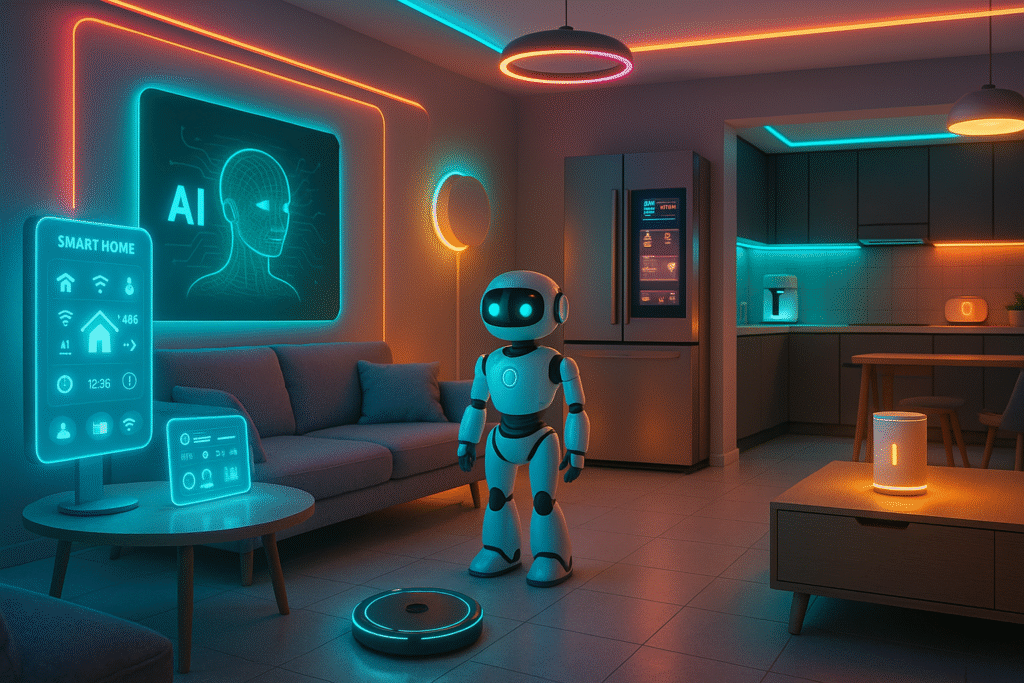The concept of a “smart home” is no longer science fiction. By 2025, homes are becoming smarter, safer, and more energy-efficient thanks to advances in IoT, AI, and home automation technologies. From intelligent lighting and security systems to AI-powered assistants and connected appliances, the modern home is evolving into a fully integrated ecosystem.
In this blog, we explore the latest smart home gadgets, automation trends, and IoT innovations that are shaping living spaces in 2025.
1. AI-Powered Smart Assistants
AI assistants are now the brains of smart homes:
- Manage schedules, reminders, and household tasks
- Control lighting, temperature, and entertainment systems
- Offer personalized recommendations based on usage patterns
- Integrate seamlessly with wearables and smartphones
By 2025, AI assistants are context-aware, predicting your needs before you ask.
2. Advanced Home Security Systems
Home security has moved far beyond alarms and cameras:
- Facial recognition cameras for authorized entry
- AI-powered motion detection that distinguishes between humans, pets, and objects
- Smart door locks that can be managed remotely
- Integrated emergency alerts to your phone or local authorities
These systems make homes safer, smarter, and more automated.
3. Intelligent Lighting & Climate Control
Smart lighting and HVAC systems provide:
- Automated energy savings
- Mood-based lighting adjustments
- Temperature regulation based on presence and habits
- Voice and app control for convenience
AI learns your preferences and optimizes comfort while saving energy.
4. Connected Kitchen & Appliances
IoT-enabled appliances make kitchens more efficient and fun:
- Smart refrigerators that track expiration dates and suggest recipes
- AI ovens that adjust cooking settings automatically
- Voice-controlled coffee machines and dishwashers
- Smart inventory management for groceries
By 2025, your kitchen can plan meals, order ingredients, and even cook automatically.
5. Home Entertainment 2.0
Entertainment systems are fully integrated:
- AI-curated playlists and movie recommendations
- Multi-room smart speakers and smart TVs
- Augmented reality (AR) and virtual reality (VR) integration
- Personalized sound and lighting effects
Your home becomes a personal entertainment hub, adapting to your tastes and preferences.
6. Energy Management & Sustainability
Smart homes are not just convenient—they’re eco-friendly:
- Solar panels connected to smart grids
- Energy monitoring dashboards for appliances
- Automated power-saving modes for devices
- AI-assisted water usage and waste management
2025 smart homes are designed to reduce carbon footprint and optimize energy efficiency.
7. Smart Health & Wellness Devices
Health monitoring is becoming part of home automation:
- Smart beds that track sleep patterns
- AI-guided exercise equipment
- Connected air purifiers and water filtration systems
- Wearables integrated with home systems for health tracking
Homes now support physical and mental wellness proactively.
8. Voice & Gesture Control Everywhere
By 2025, voice is not the only control mechanism:
- Gesture recognition for lights, media, and appliances
- AI-based predictive controls anticipating your actions
- Seamless integration with smartphones, smartwatches, and wearables
Interaction with your home becomes intuitive and natural.
9. Home Robotics
Smart homes are adopting robotics for daily chores:
- Robot vacuum cleaners and mops
- Lawn mowing and gardening robots
- AI personal assistants for reminders and household monitoring
- Delivery and inventory management robots
Automation extends from cleaning to security, making daily life easier.
10. IoT Ecosystem Integration
The future of smart homes relies on complete ecosystem integration:
- Devices from different brands work together seamlessly
- Centralized apps or dashboards control all connected devices
- AI analyzes usage patterns to optimize comfort, security, and energy
- Smart home data feeds into predictive maintenance and troubleshooting
In 2025, true interoperability makes smart homes more cohesive and intelligent.
Final Thoughts
Smart homes in 2025 are intelligent, energy-efficient, and highly connected. With AI, IoT, and automation working together, living spaces are becoming safer, more comfortable, and highly personalized.
The key trends shaping smart homes in 2025:
- AI-powered assistants and predictive automation
- Advanced security and surveillance systems
- Energy and sustainability-focused IoT devices
- Health monitoring and wellness integration
- Seamless device interoperability
Smart homes are no longer optional—they are the future of modern living.


